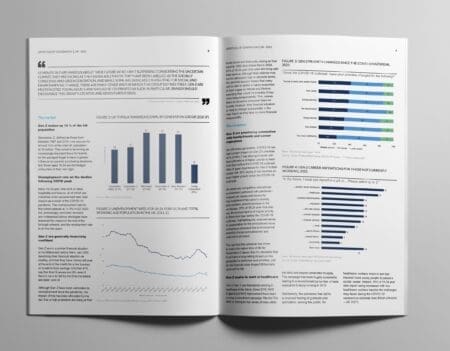-
Articles + –
Measuring up financial health
We are in the age of information. Perhaps we are in the age of too much information. Consumers today are clamoring for as much data on themselves as possible, and marketers are listening. In fact, the availability of so much information at our finger tips has made it easier than ever to measure success across every aspect of our lives. This can include anything from getting in 10,000 steps per day, sleeping 8 hours every night, and even amassing more ‘likes’ or ‘followers’ than the next person.
Peter Drucker changed the world of corporate management with the simple statement, “If you can’t measure it, you can’t manage it.” He was on to something that extended well beyond the business world. In our quest to maintain control, this obsession with having an analytical assessment of ourselves is even permeating our day-to-day financial activities.
The most familiar measurement of financial wellness is the FICO credit score. Introduced in the 1980s as the first attempt to bring some level of objectivity to the process of granting credit, it was a relatively ignored metric by the general public. It wasn’t until 2003 that the federal government required the credit bureaus to make these scores available to consumers. Fast forward 13 years, and accessing one’s credit score is now a free feature at many leading financial institutions. Just like we measure our medical health with blood pressure stats and BMIs, consumers are finally able to measure their financial health.
How can brands capitalize on the exploding interest in measuring one’s financial health?
Therein lies the challenge for financial marketers: how can brands capitalize on the exploding interest in measuring one’s financial health? The first step is increasing awareness. According to Mintel’s Unsecured Loans US 2016 report, 15% of consumers don’t know their credit score. In May, Discover became the first bank to offer FICO credit scores for free, even to those who are not Discover customers, through Discover’s new Credit Scorecard. According to Discover, “Credit Scorecard is a way for Discover to continue its leadership in promoting credit health and awareness.”
But offering access to a free credit score has been a growing trend for a number of years. According to Mintel ePerformance/eDataSource, the average monthly volume of marketing emails referencing the term “credit score” in 2016 YTD is 14.6M, up from an average of 10.5M per month in 2015. Another challenge for marketers is getting consumers to take advantage of this or other wellness-promoting services. According to Mintel’s Financial Literacy US 2016 report, fewer than half of all consumers have recently checked their credit scores. And that number is lowest among consumers who are not or have not been in a relationship. Showing these consumers how to utilize the resources at their disposal and helping them devise a plan to improve their scores would be a beneficial way for a brand to build a long-lasting relationship with its customers.
The next step in the race to promoting financial health and wellness is offering advice and being a partner in the process of managing or improving one’s FICO score. In June, Chase sent an email to Slate customers with the subject line, “[NAME], here are some tips to help you manage your credit score.” This email had a 44.5% read rate, well above the industry average of 19.7%.
Other financial brands are going beyond FICO scores and taking a proactive approach to leading their customers towards financial wellness. SunTrust Bank launched the onUp Movement to take a stand against financial stress. With over 400,000 participants, SunTrust offers tools, advice, and education in an effort to bring its members closer to financial confidence. USAA developed its own Financial Readiness Score, an online assessment to help its members gain more transparency into their overall financial preparedness.
Whether financial institutions stick to the FICO score or develop a proprietary measurement system, marketers need to look beyond just the bottom line number. From generating awareness to promoting proactive engagement, becoming a true partner on the path towards financial health will make brands a stickier part of their customer’s day-today lives.
Lily Harder is the Vice President of Research for Mintel Comperemedia. Lily specializes in the financial services industry, researching and presenting on the latest industry trends, competitive intelligence insights and newsworthy developments.

Lily Harder is Vice President of Research, Mintel Comperemedia. She specializes in financial services, researching industry trends and competitive intelligence insights.
-
Mintel StoreGet smart fast with our exclusive market research reports, delivering the latest data, innovation, trends and strategic recommendations....View reports
-
Mintel LeapMintel Leap is a revolutionary new AI-powered platform that will transform your research process....Book a demo







































